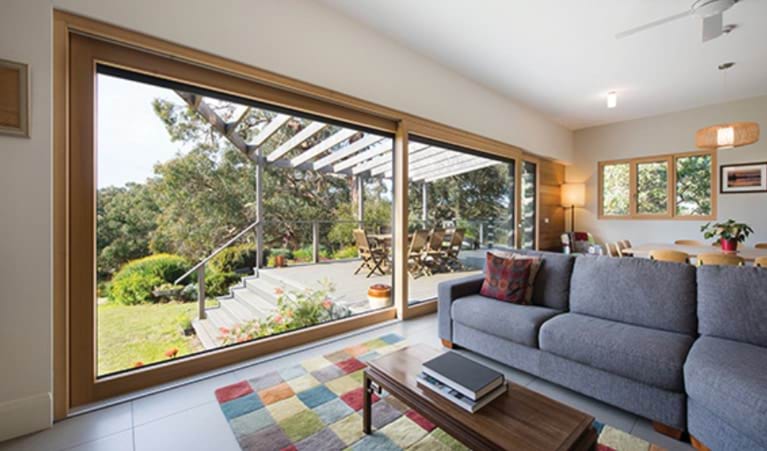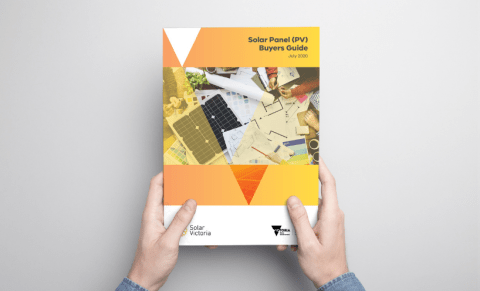Draughts can make your home far less comfortable than it should be in winter, and drive up your energy costs.
For Bellbrae residents Allan and Gail Roberts, the chill in their weatherboard home used to be unbearable in winter.
“Friends could see their breath when they stayed in the spare room,” says Allan. “It was so cold.”
They had to run their wood heater for around eight months a year, “often for 24 hours a day,” to keep the place comfortable. And in summer they needed their reverse-cycle air conditioner to stay cool.
Now, the house is “very pleasant to live in” with energy bills of around $160 per quarter. They renovated it to one of the highest international standards for airtightness and insulation. The internal temperature is around 22 to 24 °C year-round, with very little heating and no cooling.
Allan and Gail planned to install a solar PV system to lower their bills as they headed into retirement. But they knew they needed to stop the house wasting so much energy as well.

Solar panel (PV) rebate
Solar panel rebates plus the option of an interest-free loan are available for eligible Victorian homes.
Their builder son Dale, with a keen interest in the international Passive House system and energy-efficient building, upgraded the house. It’s now one of the first renovations in Australia to meet the Passive House standard for airtightness and insulation.
Their improvements included:
- insulating wall, ceiling and underfloor spaces
- installing Gutex insulative timber fibre board over the existing weatherboards
- wrapping the entire building in a vapour-permeable membrane
- re-cladding it in a combination of fibre-cement weatherboards and Colorbond
- installing triple-glazed windows.
Renew household efficiency expert Lance Turner says that with triple and even double-glazed windows beyond the budget of many households, there are many simple retrofits that can make a difference to energy use at home.
“Secondary glazing products exist (acrylic ‘window’ sheets) that can be added to windows to create an insulating airgap on the glass, much like double-glazing, or you can add a transparent window film to the glass to reduce heat loss.”
Lance says there are many reasons to seal gaps in a home. “The first is to keep conditioned air where it belongs inside the home. This reduces energy use for heating and cooling and bills, but there can be other negative effects of excessive air leakage that may not be immediately obvious, such as excessive dust or noise entering the home.”
For most people, the easiest (and most impactful) job to tackle is to seal the gaps around windows and doors where they fit into their frames.

Your guide to heating and cooling
Investing in energy-efficient heating and cooling can help you stay warm and comfortable while minimising energy costs.
“If you have a newer home with windows in good condition, then they should have decent quality seals already fitted. But for anyone in an older home with older windows, there will most likely be no seals at all.”
Lance says there are other, less obvious sources of draughts at home. “One source comes from gaps in and around appliances and fittings. Exhaust fans in kitchens and bathrooms are designed to flow large amounts of air easily. If they aren't sealed when not running, that tendency to allow airflow can continue.”
One option is to add a draught seal which sits on top of a ceiling-mounted exhaust fan and opens and closes automatically. You can also temporarily close off ducts that aren’t in use, such as evaporative air conditioners, with a duct cover.
Basic draught sealing doesn’t require special skills. If you’re new to DIY, look at the resources on the Sustainability Victoria website.
You can also hire companies that are well- versed in finding and fixing leaks.
Draught-proofing and insulation go hand-in-hand. Make sure your home has insulation in the ceiling, and the floors and walls if possible, too.
The Victorian Energy Upgrades program offers discounts to Victorian households for weather sealing and window glazing.
Having a well-sealed home will keep you more comfortable all year round. Next, you can consider energy-efficient heating and cooling systems and solar panels.
Allan and Gail Roberts are very pleased with the huge improvement to their comfort after insulating and draught proofing the home to such a high standard.
“Our energy use is low, so the next step is to add a battery system to our solar to go off-grid in the next few years and have no more energy bills.”
Updated




